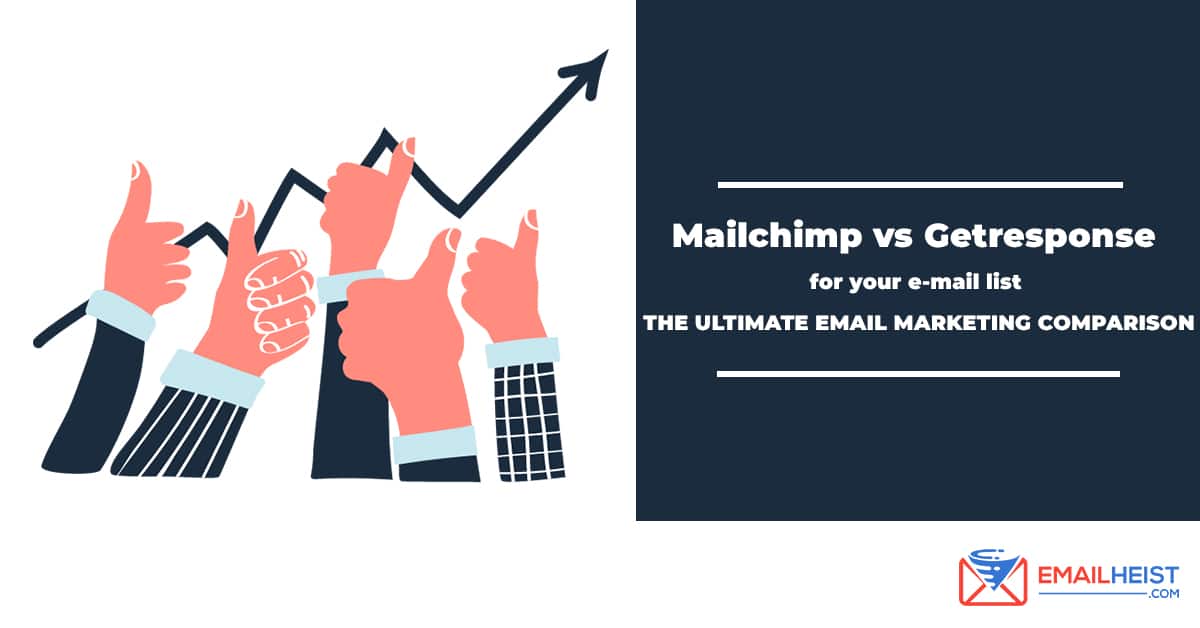Mailchimp vs Getresponse: THE ULTIMATE EMAIL MARKETING COMPARISON

Email writing might be considered a forgotten art by a lot of people but a lot of businesses still consider it one of the most powerful marketing strategies to engage with their audience and drive sales. In this comprehensive article, we will discuss and draw a comparison between the two of the most popular email software existing in the market: Mailchimp vs GetResponse.
Writing an email is the first step towards building a lasting relationship with a prospect or a happy customer or client. It may seem overrated and you may think that people don’t read emails anymore but such is not the case as businesses continue to thrive by using this strategy.
Furthermore, e-mails are considered the most effective way of generating the highest ROI for marketers across B2B industries. However, if you are not using the right email service provider, your e-mails may get lost in the box of your subscribers or target audience.
Email marketing could be challenging though. If you’ve been sending out marketing emails but your recipient doesn’t respond or take action, take that as your opportunity to do a complete email marketing overhaul. It could be easy to write an email but email marketing is on another level.
MailChimp
MailChimp was founded by Ben Chestnut and Dan Kurzius in 2001. It has over 12 million customers who send over a billion emails in a single day.
It is the ideal marketing tool for marketing professionals who have just entered the world of email marketing. MailChimp is also perfect for those who want to experiment with functionalities like a drag-and-drop editor.
If you want to use MailChimp to generate awareness for your brand, you will realize that it is a top favorite among many eCommerce companies and online stores that want to sell their products faster.
MailChimp advantages over GetResponse
Here are the advantages of using Mailchimp over GetResponse.
- Easy to sign up process
Anyone can create a free account for an unlimited time on MailChimp. No credit card details are needed at this stage. All you need is an e-mail ID. After creating your username, you’re good to go. The whole process is easy and straightforward.
- Clean interface
Once you arrive at the Dashboard after logging in, you will find a self-explanatory list of actions. You can create a campaign, upload a list of contacts, invite your colleagues, etc. the navigation process is simple. It wouldn’t take you much time to master the tool.
- Campaign types
You can create four types of campaigns on MailChimp. Please note that the campaigns are basic in nature. These are:
- Regular campaign
You can design and customize the template and content for regular campaigns. This is the most commonly used option.
- Plain text campaign
As the name suggests, it allows the users to send plain text e-mails. MailChimp offers a template for every industry and purpose since plain-text campaigns don’t appeal much.
- A/B testing campaign
MailChimp also has this functionality.
- RSS campaign
This where you can combine the content from your RSS feed with MailChimp templates.
- A/B Testing
This feature is a common component of e-mail marketing. MailChimp can create a variety of split tests based on subject lines, such as the below:
- Subject Line
You can choose up to 3 subject lines that you want to test in your campaign.
- From Name
You can choose up to 3 from the names you want to test. It can be a person’s name, your brand name, or your registered company’s name.
- Content
You can create three different kinds of email texts to test which one is more engaging.
- Send time
You can choose up to 3 days of the week or three times a day you would like to test.
MailChimp offers a variety of flexible options to ensure the best results from the split tests. After all, none of your marketing efforts or valuable time should go to waste.
- Sending messages
The whole process is simple. All you need to do is choose from a plethora of e-mail templates offered to you or code your own. A quick solution is to use the drag-and-drop elements and play with colors to come up with an engaging email.
You can schedule the email or use a paid feature called “Timewarp.” It will ensure that your subscribers receive your email at the decided time.
MailChimp can also calculate the best time to send emails for better results and save your email from getting lost under the pile of other emails in the subscriber’s inbox.
- Contact management
The free version of MailChimp allows you to add up to 2000 unique contacts. You can create as many lists as you want. You can even create multiple groups depending on the interests and preferences of subscribers.
You can also create segments on the toll called “segment,” a collection of subscribers based on shared qualities, such as engagement activity and group choices.
An excellent feature of MailChimp is that you can add subscribers from the signup forms on the web, Facebook page, etc. This email marketing software helps in engaging customers and acquiring new ones from anywhere on the internet rather quickly.
- Automation
The most important feature of MailChimp is automation. Like in other marketing software, it is possible to create workflows in MailChimp. You can create a targeted series of emails that get triggered by your subscriber’s activity or on a specific date or event.
GetResponse
This platform boasts of being the “world’s easiest email marketing platform.” It was launched in 1997 by Simon Grabowski. GetResponse has been in the market way before MailChimp started. (READ: GetResponse Review)
It currently serves 350,000 customers across 182 countries. This tool is available in 21 different languages. This platform offers top-notch quality marketing solutions to business owners to help them grow their business.
Advantages of GetResponse over MailChimp
- Email design types
GetResponse offers more than 500 pre-designed templates and 1000 free iStock images. It doesn’t matter which industry you belong to or the purpose of your email, GetResposne has you covered.
It also has a drag-and-drop and HTML editors. If you want to use any of the templates and add your elements, you can do that too. Otherwise, a coder in your team can create an email for you from scratch easily.
- Responsiveness
What would you feel if you cannot read an e-mail on your mobile phone or tablet? You need to understand that people will not always check their emails on the desktop. They are going to read emails on the phone or tablet, too.
Fortunately, GetResponse has an in-built feature that allows you to see how your emails look on a phone from a dashboard itself. It’s free of cost and an excellent feature if your studies show most of your subscribers’ open emails.
- Advanced segmentation
No customers are alike. They will always respond to emails differently. That’s why you need to keep your emails as engaging and personalized as possible.
GetResponse can create multiple campaigns for multiple groups of people. You can use different images and CTAs to spread the information to your target audience.
- A/B Testing
It’s quite easy to do a split test on GetResponse since this feature is integrated into the Settings section by default. You can A/B test an email campaign with up to 50% of the subscribers with the help of a handy slider. The whole process is quite simple and hardly takes a couple of minutes to set up.
- Email marketing automation
Unlike MailChimp, you can create a visual flowchart of your automated emails easily. It makes executing drip email campaigns a fun activity. All you need to do is create a diagram of responses you want to email to your subscribers.
In GetResponse, you can create hundreds of scenarios and keep a response ready for every subscriber’s action. Online businesses can make good use of this feature, especially to re-engage people who have abandoned their shopping carts.
- Perfectly-timed delivery of emails
GetResponse offers a life-changing feature that allows the tool to predict the optimal delivery hour in a day to send emails. With this feature, you can be assured that your emails will always land at the top of the subscriber’s inbox.
- Landing pages
If you need to create high-converting emails, GetResponse can make that happen. You can design a landing page from scratch by choosing from a pool of 1,000 iStock photos. The feature has the drag-and-drop option, which makes it easy to create a page quickly.
Get our FREE course on AFFILIATE MARKETING straight to your inbox
This course includes video tutorials on how to do email marketing.
The Verdict: MailChimp vs GetResponse
GetResponse is the clear winner between the two. It has a stronger, faster, and has a better, more transparent pricing structure.
With GetResponse, you can build landing pages, automate marketing more efficiently, create stunning e-mails, and use sales funnel templates to bring in more qualified leads with next to zero efforts.
GetResponse is better and the best choice if you want to expand your business and maximize your e-mail marketing strategies.
(READ More: MailChimp vs GetResponse vs Aweber)


